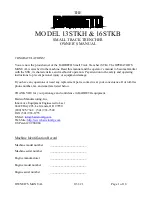
The
Articulated Shank™
can also be used as a 'daisy chain” connector between the front and rear
hooks in a two-hook articulated fly system.
The smallest size shank (20mm) can be used as an alternative to the “loop-and-beads” connector
system that is a common method used today as illustrated below.
Basic Tying Steps using the Articulated Shank (AS)
1. Begin by tying materials to the
rear hook
to create the tail of the fly.
2. Take the finished rear hook (tail) out of the vise and fit it on the loop of a
20mm Articulated
Shank (AS)
. Put the AS in the vise and use tight thread wraps to close off the loop. The rear hook
now has the AS firmly secured to it as a “connector.” You can then add some body materials to the
AS to build out the middle section of the fly. Take the AS out of the vise.
3. Insert the
front hook
into the vise.
4. Using a strong piece of mono (or similar line), tie the eye of the 20mm Articulated Shank (AS) to
the back of the front hook using a small loop. Use firm thread wraps to secure the mono along the
length of the hook shank and then double-back/wrap-back for added strength. Note: The eye of the
AS should almost touch the back of the front hook, but you should ensure that the mono loop
remains big enough to allow freedom of movement in the joint to give action to the fly.
5. Continue adding body materials to the front hook to build the body and head of the fly. Finish the
fly in the normal way.
You now have a two-hook articulated fly that has two articulation joints.
4. As a connector in two-hook articulated flies.
“Loop-and-Bead” System
Key Benefits:
●
The built-in loop of the Articulated Shank™ replaces the need to build a mono “loop” or “loop &
bead” system between front and back hooks.
●
Two distinct points of articulation promotes more freedom of movement. The AS positioned
between the front and rear hooks creates a front hook-to-AS joint and a rear hook-to-AS joint.
●
Provides a stronger and stiffer connection reducing fouling problems when casting.
●
Creates an “Invisible connection.” The body materials can now be tied all the way back to the
loop/hook connection point. This eliminates any material gaps between the body and tail that are
sometimes visible with traditional methods.
Using the Articulated
Shank™ as a connector

























